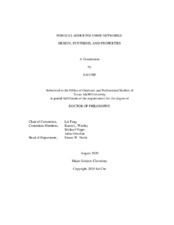| dc.description.abstract | This dissertation describes the research on the design, synthesis and properties of porous ladder polymer networks (PLANs), which can be defined as porous organic polymers featuring full ladder type backbone. Porous Organic Polymers (POPs) are a class of permanently porous materials whose entire organic framework is crosslinked by covalent bonds. The high porosity, structural diversity, and thermal/chemical stability of POPs render them promising candidates in gas adsorption, catalyst, sensors, etc. Meanwhile, ladder polymers with fused-ring rigid backbones have demonstrated various unique properties that are not accessible on conventional polymers with non-fused backbones. In the past decade, numerous efforts have been devoted to incorporate fully-fused ladder-type constitution into POPs, affording the so-called PLANs. Advancements of this field in the past decade lead to the development of exciting PLAN materials embracing advantages from both worlds of POPs and ladder polymers. These synergistic properties include but are not limited to: (1) extraordinary stability in terms of chemical constitution and porosity; (2) low entropy backbones that favor gas adsorption process; and (3) extended pi-conjugation for better charge transport.
This dissertation begins with a introduction of the development of PLAN constructed from a variety of geometry topologies and synthetic strategies (Chapter I). The reported synthetic strategies as well as the corresponding properties of PLAN are identified and discussed. Then the perspectives on the promising future direction of this field are presented.
Chapter II describes the synthesis of an example of truxene-based PLAN through Suzuki crosslinking followed by ring-closing olefin metathesis ladderization. Thermodynamically controlled ring-fusing step allowed for the formation of complete ladder type backbone with minimal backbone defects. This crosslinking followed by ladderizaion method offers a universal strategy of introducing ladder-type backbone into porous system heterogeneously.
Chapter III presents the proof of concept of using a ladder-type backbone in POP to achieve more entropically favorable methane adsorption, based on the PLAN described in Chapter II. Thermodynamic investigation revealed a significantly smaller entropy penalty of PLAN upon high-pressure methane uptake compared to its non-ladder-type counterpart. This entropic approach can serve as a new general strategy to further enhance methane storage capacity of porous materials.
Chapter IV presents a new synthetic approach to porous graphitic carbon, which can also be viewed as a subclass of PLANs. Bottom-up synthesis of PGC was achieved through a one-pot reaction involving crosslinking and graphitization. The framework was crosslinked by MSA-mediated aldol triple condensation reaction, while the pre-organized aromatic moieties allowed for cyclodehydrogenation to complete the graphitic structure. This PGC material is equipped with regulated ultramicropores with facile graphitization process, allowing for its application in electrocatalysis and chemiresistive sensing.
The main purpose of the work presented in this dissertation is to (1) establish efficient and versatile strategies to PLAN construction and (2) understand the fundamental correlation between ladder-type backbone and their application-relevantproperties. Building up on this work and the rapid development by others in this field, promising applications of PLANs in energy storage, gas separation, highly selective and sensitive sensors, and electrocatalysis are anticipated. | en |


